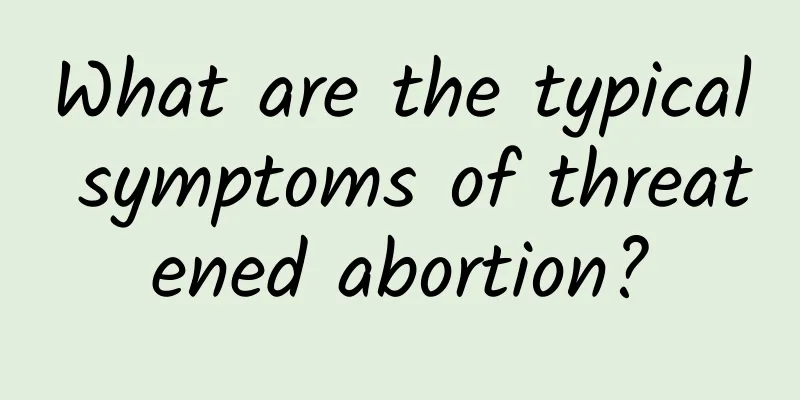What are the typical symptoms of threatened abortion?

|
Typical symptoms of threatened abortion include vaginal bleeding, lower abdominal pain or distension, lower back pain, etc. When these symptoms occur, you should seek medical attention promptly to get a clear diagnosis and take appropriate measures to preserve the fetus. 1. Vaginal bleeding: This is the most common sign of threatened abortion, usually manifested as a small amount of vaginal bleeding, mostly bright red or dark red, and may be accompanied by bloody discharge. Some pregnant women bleed less, sometimes similar to menstrual flow, but this situation should not be ignored, because even slight bleeding may indicate that the gestational sac is threatened. If the amount of bleeding increases or is accompanied by blood clots, you should seek medical attention immediately. 2 Lower abdominal pain or distension: Some pregnant women may experience persistent or intermittent pain or distension in the lower abdomen, which may be similar to menstrual pain. This symptom often indicates that the uterus is undergoing atypical contractions, which may have an important impact on the instability of the fetus. If the pain worsens or spreads to the lower back, seek medical help as soon as possible. 3. Waist pain: Waist pain is also a common early sign, but it is more likely to be ignored than other symptoms. In the early stages of pregnancy, many pregnant women will feel slight waist discomfort due to uterine expansion and hormonal changes, but if this pain is significantly intensified or accompanied by other symptoms, you should be more vigilant. 4Other possible symptoms: Some pregnant women may experience systemic symptoms such as nausea, fatigue, dizziness, etc. These are usually related to hormone fluctuations in the body. When the symptoms are too obvious, check as soon as possible. The following measures can be taken to deal with the above symptoms: Drug treatment: Depending on the situation, your doctor may recommend tocolytic drugs, such as oral or injected progesterone, to help stabilize the pregnancy. Rest and fetal protection: Reduce activity, avoid lifting heavy objects and standing for long periods of time. It is recommended to rest in bed to reduce pressure on the fetus. Medical examination: B-ultrasound examination is used to clarify the development of the embryo, and the levels of β-HCG and progesterone in the pregnant woman's blood are monitored to provide a reference for treatment. When any abnormal symptoms are found, it is crucial to seek medical attention in time. Knowing and recognizing the symptoms of threatened abortion in advance can help pregnant women take correct measures at the first time to gain a greater chance of preserving the fetus and safety. In daily life, maintaining a good work and rest schedule and healthy eating habits can also effectively reduce the risk of threatened abortion. |
<<: Pelvic cystic mass after abortion
>>: Why does hydatidiform mole form?
Recommend
Can I get pregnant if my hyperprolactinemia has dropped?
Many people have heard of hyperprolactinemia and ...
How to take care of women with cervical warts
Cervical warts are a very serious disease. Genera...
Feeling sleepy after breakfast? It’s the bread with sweet milk tea that’s to blame! 3 low-sugar breakfasts full of energy
Getting up in the morning and having breakfast gi...
Strengthen immunity, top 10 anti-epidemic ingredients are on the list! Nutritionist: Broccoli, nuts, garlic, etc. can improve antioxidant capacity
The number of local cases has exceeded 100 one af...
Brief analysis of several common treatment methods for vulvar leukoplakia
Among the common methods of treating vulvar leuko...
Brief analysis of common symptoms of chronic adnexitis
Chronic adnexitis is a common type of adnexitis, ...
Are there serious side effects of long-acting oral contraceptives?
Many women find it troublesome to take quick-acti...
Experts analyze the causes of uterine fibroids
There are many causes of uterine fibroids, but no...
What causes cervicitis? How to effectively treat cervicitis?
The incidence of cervicitis among gynecological d...
What medicine should I take to treat amenorrhea for three months?
What medicine should I take to regulate my amenor...
Treatment of Dysfunctional Uterine Bleeding with Artificial Cycle Therapy of Traditional Chinese Medicine
The artificial cycle therapy of traditional Chine...
What are the symptoms of irregular menstruation?
What are the symptoms of irregular menstruation? ...
What foods can't be eaten after uterine fibroid surgery? What foods can't be eaten after uterine fibroid surgery?
What dishes can’t be eaten after uterine fibroid ...
Homemade purple golden rice dumplings! Avoiding the hidden hunger crisis
The Dragon Boat Festival is approaching, and look...
What foods can cause miscarriage during early pregnancy? Stay away from these 7 foods
Diet during pregnancy is very important for pregn...









